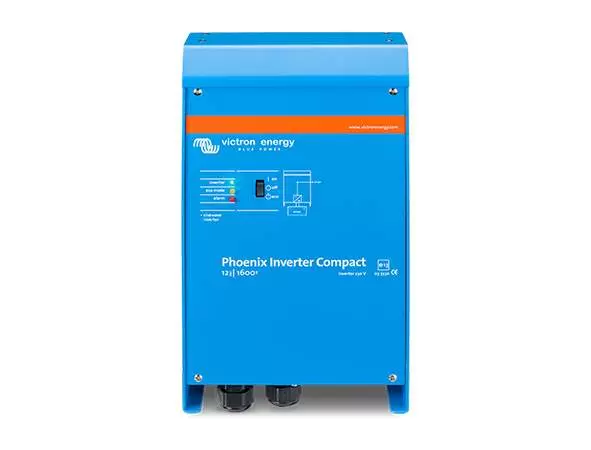Are you ready to hit the open road and embrace the great outdoors in your trusty RV? Whether you’re a seasoned nomad or a weekend warrior, understanding how to keep your home-on-wheels powered up is essential for an unforgettable journey. Enter the unsung hero of recreational vehicle energy systems—the RV inverter! This incredible device transforms your battery’s DC power into AC power, allowing you to use all those modern conveniences that make life on the road so much sweeter. But with so many options available, how do you choose the right one for your adventures? Fear not! In this comprehensive guide, we’ll break down everything you need to know about RV inverters.
What is an RV Inverter?
An RV inverter is a vital component of any recreational vehicle (RV) that allows you to use household appliances and electronics while on the road. It is essentially a device that converts the direct current (DC) power from your RV’s batteries into alternating current (AC) power, which is what most household devices and appliances require to function.
In simpler terms, an RV inverter acts as a bridge between your RV’s 12-volt battery system and the standard 120-volt AC electrical outlets found in homes. This enables you to use various electronic devices such as televisions, laptops, hairdryers, and even kitchen appliances like microwaves and coffee makers.
There are two main types of inverters available for RVs: pure sine wave inverters and modified sine wave inverters. Pure sine wave inverters produce high-quality AC power that is similar to what you would get from a standard electrical outlet at home. On the other hand, modified sine wave inverters produce a stepped or choppy version of AC power that may not be suitable for some sensitive devices.
When selecting an inverter for your RV, it’s essential to consider several factors such as its power rating, size, efficiency, and safety features. The power rating of an inverter determines how much wattage it can handle at once. For example, if you plan on running multiple high-powered devices simultaneously in your RV, you will need an inverter with a higher wattage rating.
The physical size of an inverter also matters as it needs to fit comfortably into your RV’s existing setup without taking up too much space. You should also look for efficient models that convert DC power into AC with minimal loss of energy. This will help prolong your battery life and save on fuel costs when using generators or solar panels to recharge them.
Safety features are crucial when dealing with electricity; therefore, ensure your chosen inverter has built-in protections such as overload, overheat, and short-circuit protection. These will help prevent damage to your devices and RV’s electrical system in case of any unexpected power surges.
An RV inverter is a crucial piece of equipment that allows you to enjoy the comforts of home while on the road. It provides a convenient and reliable source of AC power for all your electronic devices, making your adventures more comfortable and enjoyable. When selecting an inverter for your RV, consider the factors mentioned above to ensure you get the best fit for your needs.
How does an RV Inverter work?
An RV inverter transforms DC power from your battery into AC power, making it possible to run household appliances. This process is essential for enjoying the comforts of home while on the road. When you connect your RV to a power source or solar panels, energy flows into the batteries. The inverter then takes this stored direct current and inverts it into alternating current.
This conversion allows you to operate devices that require standard wall outlets, like microwaves or televisions. Most inverters also include built-in safety features to protect against overloads or short circuits. Understanding how an inverter operates helps you manage energy consumption efficiently. By knowing which devices can be powered simultaneously, you’ll make informed choices during your adventures without draining your batteries too quickly.
Types of RV Inverters
When exploring the world of RV inverters, it’s essential to know that not all are created equal. There are primarily three types: modified sine wave, pure sine wave, and grid-tie inverters.
Modified sine wave inverters are the most affordable option. They convert DC power into a choppy waveform. This type works for many devices but can cause issues with sensitive electronics. Pure sine wave inverters generate a smooth output similar to household electricity. They’re ideal for running delicate appliances like medical devices or audio equipment without any distortion.
Grid-tie inverters allow your RV to connect back to the electrical grid. This is perfect if you want to harness solar power and sell excess energy back during peak production times. Each inverter serves unique needs and preferences, so understanding their differences will help you make an informed choice for your adventures ahead.
Benefits of Having an RV Inverter
An RV inverter offers a world of convenience for travelers. By converting DC power from your batteries to AC power, it allows you to use standard household appliances wherever you roam. Imagine brewing coffee in the morning without needing a campground hookup. With an inverter, that’s possible. You can run microwaves, TVs, and even small air conditioners while off-grid.
Having an RV inverter also enhances comfort during long trips. It enables charging devices like laptops and smartphones, keeping everyone connected and entertained. Moreover, it adds versatility to your adventures. Whether parked at a scenic overlook or camping deep in the woods, your electrical needs are covered.
Safety is another prime benefit. Using an inverter minimizes risks associated with generators, such as noise pollution and carbon monoxide exposure. Enjoy peace of mind as you explore the great outdoors!
Factors to Consider when Choosing a Pv Inverter
When it comes to powering your RV adventures, choosing the right inverter is a crucial decision. A PV inverter, also known as a solar inverter, converts the direct current (DC) electricity produced by your RV’s solar panels into alternating current (AC) electricity that can power your appliances and devices.
But with so many options available on the market, how do you know which PV inverter is best for your RV? Here are some key factors to consider when making your decision:
1.Power Output
The first thing to consider is the power output of the PV inverter. This will determine how much electricity it can convert and supply to your RV’s electrical system. It is important to choose an inverter that can handle all of your energy needs, including high-demand appliances like air conditioners or microwaves.
2. Type of Inverter
There are three main types of PV inverters – string inverters, microinverters, and power optimizers. String inverters are the most common type and connect all of your solar panels together into one central unit. Microinverters are installed on each panel individually and allow for more flexibility and efficiency. Power optimizers work similarly to microinverters but allow for more control over individual panels’ performance.
3. Efficiency
Another important factor to consider is the efficiency of the PV inverter. This refers to how well it converts DC electricity into AC electricity without wasting energy as heat or other forms of loss. Most modern inverters have high efficiencies ranging from 95% to 98%, but it’s always worth considering this factor when comparing different models.
4. Durability
Since RVs often encounter rough roads and harsh weather conditions during travels, it’s essential to choose a durable PV inverter that can withstand these challenges. Look for models with sturdy construction and good warranties.
5.DC Voltage Range
Solar panels produce DC electricity in varying voltages, and the PV inverter must be able to handle this range. It’s essential to choose an inverter with a wide input voltage range so that it can still function efficiently even if your panels’ output fluctuates.
By considering these factors when choosing a PV inverter for your RV, you can ensure that you have a reliable and efficient source of electricity during all of your adventures on the road. Remember to do thorough research, compare different models, and consult with professionals if needed before making a decision.
Installation and Maintenance Tips for RV Power Inverter
Installing a power inverter in your RV can provide you with the convenience of having access to AC power while on the road. However, it is important to properly install and maintain your RV power inverter to ensure its longevity and safe operation. Here are some tips to help you with the installation and maintenance process.
1. Choose the Right Location:
The first step in installing an RV power inverter is choosing the right location for it. The ideal location should be well-ventilated, away from moisture or extreme heat, and easily accessible for maintenance purposes. It should also be close enough to your battery bank for easy connection.
2. Follow Manufacturer’s Instructions:
When installing your power inverter, always refer to the manufacturer’s instructions for specific guidelines. Different models may have different installation procedures, so it is important to follow them carefully.
3. Use Proper Wiring:
Proper wiring is crucial when installing an RV power inverter. Make sure to use wires that are specifically designed for high voltage applications and are capable of handling the amperage output of your inverter.
4. Connect Directly to Battery Bank:
It is recommended to connect your RV power inverter directly to your battery bank rather than through a fuse box or breaker panel. This will ensure a direct current flow without any interruption.
5. Check Connections Regularly:
Regularly check all connections between the battery bank, fuse box (if applicable), and the power inverter itself. Loose connections can lead to overheating and potential damage.
6. Keep Inverter Away from Water:
It is important to keep your RV power inverter away from water at all times as moisture can cause short circuits or corrosion on exposed metal components.
By following these installation and maintenance tips, you can ensure safe and efficient operation of your RV power inverter while on your adventures. Remember to always refer to the manufacturer’s instructions for specific guidelines and seek professional help if needed. Happy travels!
Common Problems with RV Inverters and How to Troubleshoot Them
RV inverters can face a few common issues that might leave you scratching your head. One frequent problem is low output voltage. If you notice devices aren’t performing as they should, it could be due to faulty wiring or a blown fuse. Another issue is overheating. Many inverters have built-in safety features, but persistent heat may signal a need for better ventilation or an overloaded unit.
Sometimes, users report strange noises coming from the inverter. This could indicate loose connections or internal components that require attention. If the inverter won’t turn on at all, check the battery connection first. Ensure everything is wired correctly and there are no signs of corrosion. Regular maintenance goes a long way in preventing these problems. Keep an eye on performance and address any irregularities promptly to keep your RV adventures powered up seamlessly.
Conclusion
A reliable RV inverter can truly transform your outdoor adventures. It allows you to enjoy the comforts of home while on the road, providing power for essential appliances and devices. Whether you’re charging electronics, running a microwave, or powering lights, an inverter makes it all possible. Choosing the right inverter depends on your specific needs and lifestyle. Take into account factors like wattage requirements and types of appliances you’ll be using. Don’t forget about installation—proper setup is key to maximizing performance. Regular maintenance will ensure that your RV inverter serves you well for years to come. Keep an eye out for common issues so you can troubleshoot quickly if needed.
FAQs
1. What is an RV inverter and why do I need one?
An RV inverter is a device that converts direct current (DC) power from your RV’s battery into alternating current (AC) power, allowing you to use household appliances and electronics on the go. It is essential for those who love to travel and want the convenience of using their devices while off-grid or when the RV is not connected to shore power.
2. How much power does an RV inverter provide?
The amount of power provided by an RV inverter depends on its size and capacity. Most inverters range from 300 watts to 3000 watts, with larger inverters providing more power. It’s important to choose an inverter that can handle the wattage of all your devices combined.
3. Can I run my entire RV on an inverter?
While it is possible to run most of your RV on an inverter, there are limitations. For example, large appliances like air conditioners and microwaves require a lot of power and may not be able to run solely on an inverter. It’s best to consult with a professional or refer to the manufacturer’s guidelines before attempting to run these types of appliances through your inverter.
| Related Business Listings |
| Contact Directory |
| Local Business Profiles |




